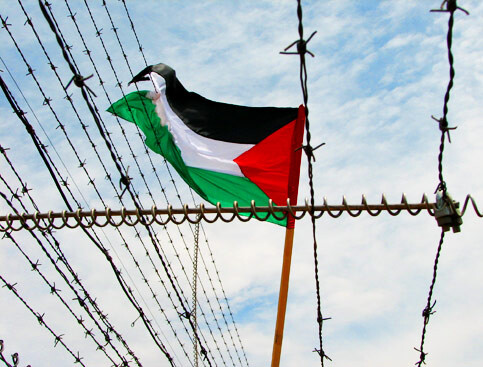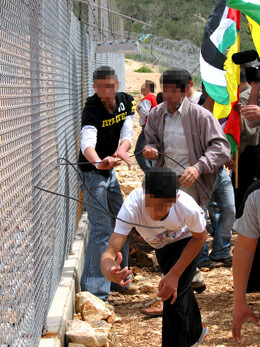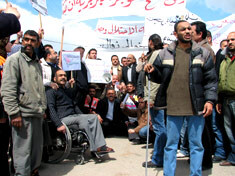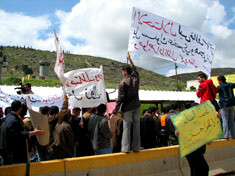
Palestinian demonstrators in Salfit hang Palestinian flags along the razor wire lining Israel’s barrier in the West Bank.
It’s been more than three weeks since I last wrote. The reason is simple: things have been awful on the ground here in Palestine, leaving little time for reflection. As usual, Passover —- the Jewish holiday celebrating freedom from oppression —- was accompanied by tightening restrictions on Palestinians. While Jewish Israelis were feasting nearby, travel within the West Bank became difficult if not impossible, except of course for settlers who would breeze by the hundreds of Palestinians waiting for hours at checkpoints on their way home, to work, to the hospital, or elsewhere. Calling the Army was no help since most offices and services were closed for the holidays. Palestinians urgently requiring permits to reach hospitals were forced to wait as well.
A quick look at the Palestinian Center for Human Rights’ weekly report shows that Israeli Occupation Forces (IOF) —- among other activities —- killed nine Palestinians (including two children and four extrajudicial assassinations), injured 20, conducted 30 incursions into West Bank Palestinian communities, arrested 44 Palestinian civilians (including eight children), demolished eight houses rendering more than 48 people homeless, and continued to impose a total siege on the Occupied Territories … all in the past week. This is about average. In the past few weeks, Israeli settlers have also moved back into an evacuated settlement in Nablus. Meanwhile, several hundred Jewish settlers took over a massive building in the heart of Hebron, and Israel immediately deployed soldiers to protect the new Jewish-only colony. The nearby Abu Haykal family, friends whom I visited last month in Tel Rumeida, had their car torched by Hebron settlers who want nothing more than for them to leave so that a new Jewish settlement can be set up next to the already existing ones.
The ongoing brutality and harassment are fuelling a growing tension that will likely one day explode into a third intifada (Arabic for “uprising”). The signs are there —- intense frustration but an even stronger determination to throw off the Occupation’s yoke. Demonstrations have been happening all over the West Bank, sometimes several per day. Israel’s excessive force and continued colonization are unsustainable, because the Palestinians will never stop resisting. To stop resisting is to have no future —- it is national suicide. The worse the Occupation gets, the stronger the resistance.

Jit Checkpoint in early April: Passover - the Jewish holiday celebrating freedom from oppression - is accompanied by tightening restrictions on Palestinians in the West Bank.
Although it is not reported as such, most of the current Palestinian resistance has been nonviolent. At the Arab American University of Jenin, the “Green Resistance” student group succeeded in banning the Israeli-produced Tapuzina fruit juice from the AAUJ campus, part of a growing Palestinian campaign to support local products rather than paying for their own Occupation. My neighbor Abu Saed in Haris, whose trees have been uprooted by settlers three times over the past month from his land near Revava settlement, continues to replant them week after week, with support from Rabbis for Human Rights and International Women’s Peace Service (IWPS). And about a month ago, more than 350 people —- Palestinians, Israelis, and internationals —- gathered for the first-ever Palestine International Bike Race from Ramallah to Jericho, an event organized by the East Jerusalem YMCA for people from all over the world to protest human rights violations in Palestine, demand freedom of movement for Palestinian civilians, and “support the values of peace and tolerance in the area.” The event was projected to be the longest ever international sporting event protesting the Occupation, but Israeli jeeps cut the race short by closing traffic to two-wheelers and the “Bikes not Bombs” enthusiasts were forced to turn back.
Near the Quaker Friends School where the bike race commenced is a cultural center where dozens of Palestinian youth come together every week to make short films and dance together. After watching an intensely physical and emotive modern dance rehearsal when I visited one day, the students explained that for them “art is not a luxury —- it’s a must.” The Occupation not only threatens Palestinians’ homes, land, livelihoods, time, and future, but also creativity and expression. The cultural center is a tool to prevent Palestinian culture from being lost or distorted, and students described how they would meet in secrecy to quietly practice during invasions and curfews as their own form of creative nonviolent resistance.

Demonstrators from Salfit remove the electric sensory wire lining the Wall that has cut their town off from their land and Salfit’s main road. The faces of demonstrators have been blurred to protect their identities.
Fuad said he chose to work in the Salfit area because of its history of nonviolent resistance. Indeed, the past few weeks have seen a number of major actions in our oft-forgotten rural region. On Land Day, hundreds gathered in Rafat village to protest the Wall that is slowly enclosing their village, but when they found the cage unguarded they grabbed hold and began to rock it, back and forth, all together, until finally the gates exploded open. When the soldiers arrived, protesters retreated to their homes, not a single stone thrown. They had made their point: Rafat will not accept collective imprisonment.
The next day in Salfit town a group of demonstrators found the Wall unguarded and began removing the electric sensory wire that lines the fenced sections. Soldiers arrived quickly and began shooting into the air, but protesters held their ground and raised Palestinian flags above the cage that cuts off their main road and annexes much of their land. Salfit, too, will not accept collective imprisonment. Nor will the rest of the West Bank, where many other actions took place on Land Day weekend. In Qaffin town in the north, thousands of demonstrators gathered and marched, danced, and drummed their way to the Wall to show their spirit and resolve to resist the illegal barrier and Occupation. In Nablus, hundreds marched to Beit Furik, one of the six city exits —- all army checkpoints —- through which men 16 to 45 years old are not allowed to pass without a special Israeli-issued permit that can only be obtained outside the city. The march, organized in part by the Nablus Women’s Union and a society for local handicapped people, continued through the checkpoint past stunned soldiers unable to hold the cheering protesters back. The group then occupied the checkpoint, first by sitting down and later by climbing atop the waiting pens and hanging Palestinian flags and freedom signs around the base.

Nablus residents march to Beit Furik checkpoint, the action was organized by the Nablus Women’s Union and the Society for Handicapped People in Nablus.

After succeeding in pushing through Beit Furik checkpoint, Nablus residents occupy the checkpoint, climbing up onto the waiting pens and hanging freedom signs around the base.
Injustice is unsustainable. It cannot be normalized, because there will always be resistance. The third intifada will come. It may be nonviolent as the first, or it may be more like the second. Is it a coincidence that Israel began construction at the Temple Mount holy site in Jerusalem just as warring religious and secular Palestinian factions were coming to a truce? Israel prefers that Palestinians resist one another rather than their oppression, but Palestinians in the West Bank and at the negotiating table have shown their resolve to work together against their common enemies: Zionist racism and the Occupation. United, they will prevail. If the third intifada does not succeed, there will be a fourth. And then a fifth … as many as it takes, until justice is realized.
All images by Anna Baltzer.
Anna Baltzer is a volunteer with the International Women’s Peace Service in the West Bank and author of the book, Witness in Palestine: Journal of a Jewish American Woman in the Occupied Territories. For information about her writing, photography, DVD, and speaking tours, visit her website at www.AnnaInTheMiddleEast.com



